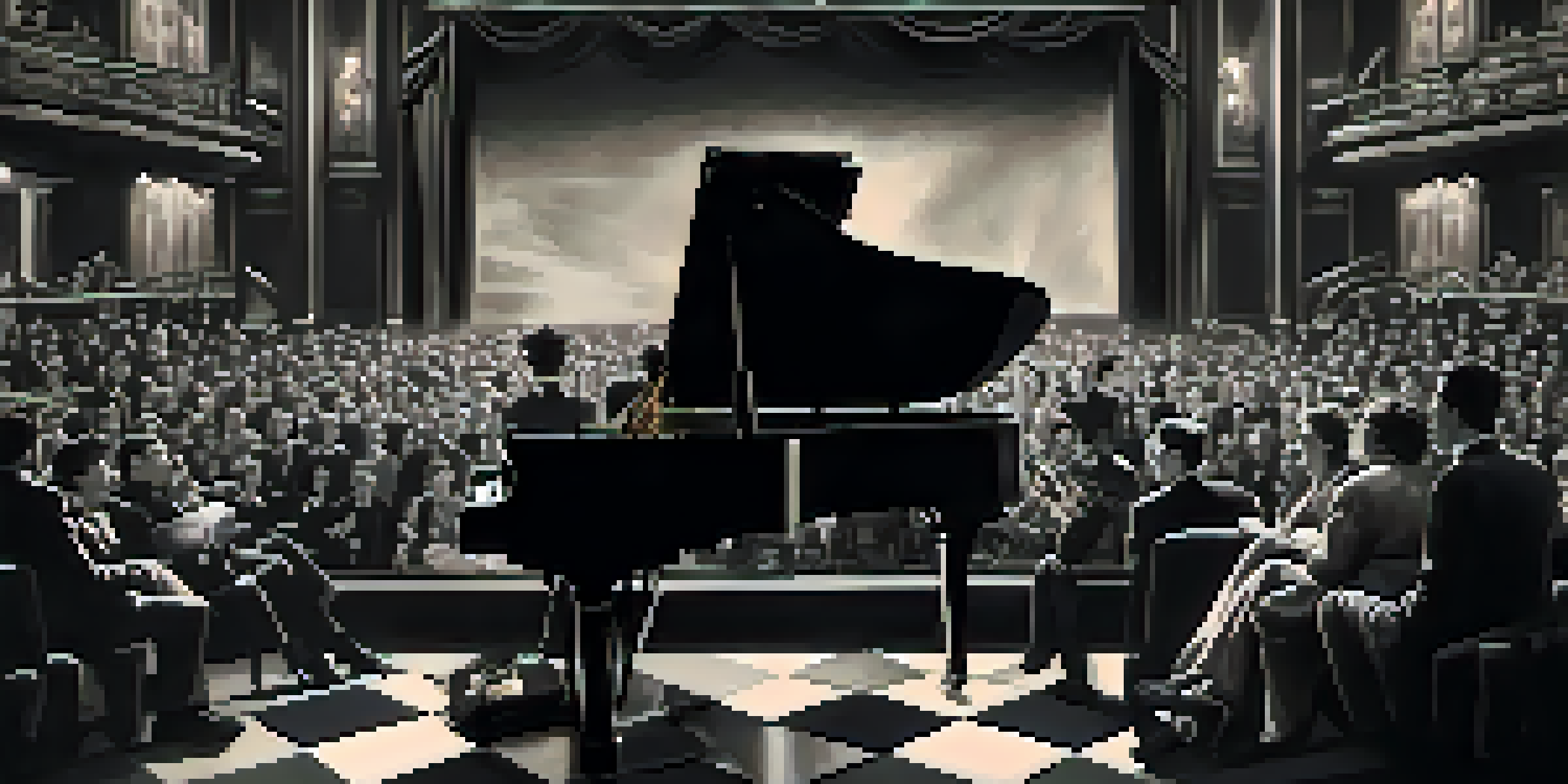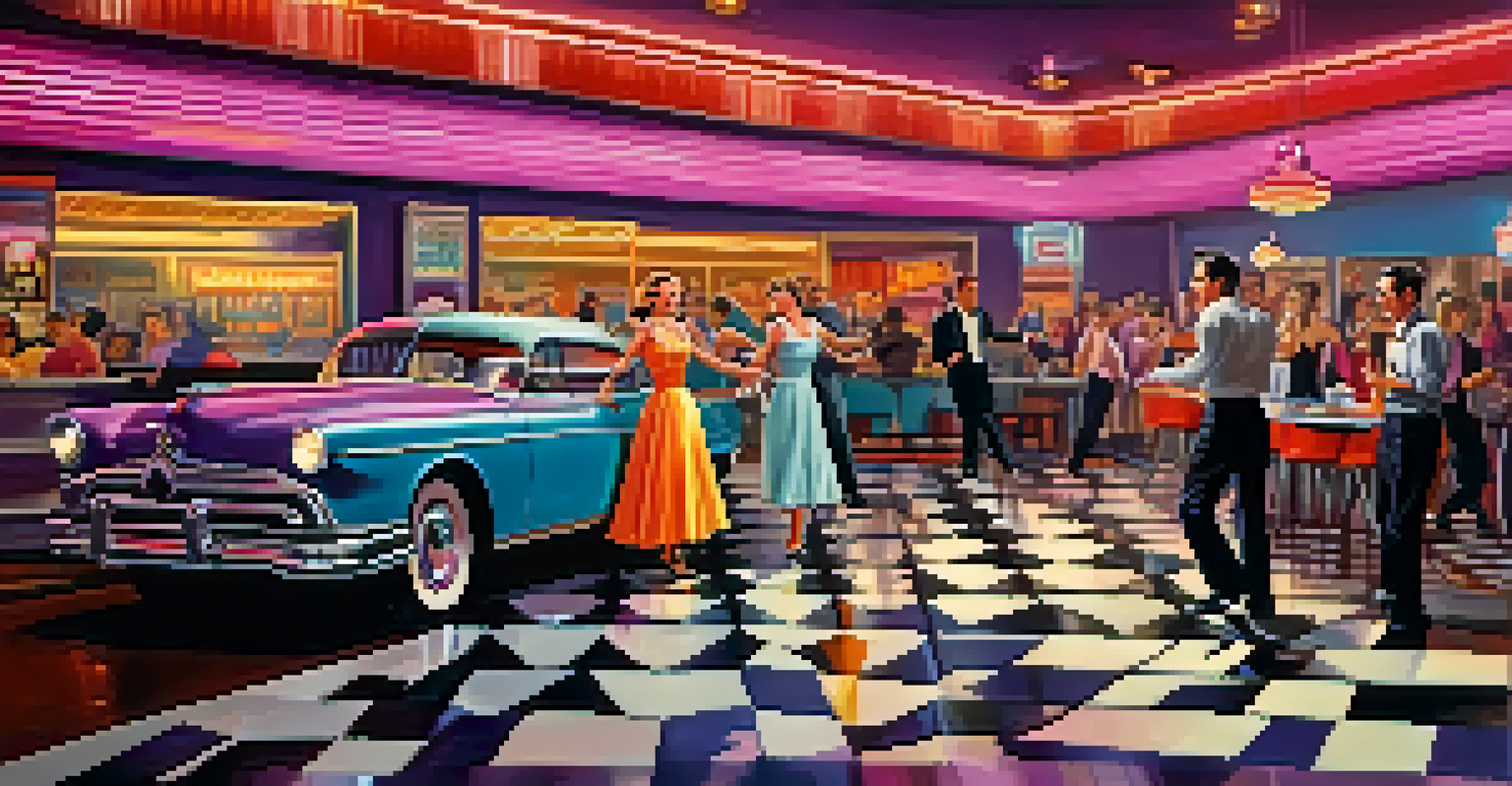The Evolution of Music Genres Through Hollywood Films

The Birth of Soundtracks: Silent Film Era to Talkies
In the early days of cinema, films were silent, accompanied by live music. This music set the tone and mood, enhancing the storytelling. As sound technology advanced, films transitioned to 'talkies,' allowing dialogue and music to coexist, creating a richer experience.
Music is the shorthand of emotion.
The transition to sound opened doors for various music genres to enter the film world. Jazz became hugely popular in the 1920s and 30s, reflecting the cultural shifts of the time. Movies like 'The Jazz Singer' showcased the power of music, leading to a significant evolution in film soundtracks.
This period marked the beginning of music's central role in cinema, influencing genres that would emerge in later decades. The intertwining of film and music laid the groundwork for a relationship that continues to evolve today.
The Golden Age of Musicals: 1930s to 1950s
The 1930s to 1950s is often referred to as the Golden Age of Musicals, where films like 'Singin' in the Rain' and 'West Side Story' defined the genre. During this time, Broadway and Hollywood collaborated, bringing theatrical music to the big screen. These films not only entertained but also showcased a variety of musical styles, from classical to jazz.

Musicals played a significant role in popularizing music genres across America. They introduced songs that became cultural phenomena, influencing fashion, dance, and social trends. The catchy tunes and elaborate choreography captivated audiences and created a lasting legacy.
Music Transforms Film Experience
From silent films to modern cinema, music has evolved to enhance storytelling and create emotional connections.
As a result, the musical genre paved the way for future film adaptations of popular stage shows, showing how music could bridge the gap between different forms of entertainment. This era solidified the importance of music in enhancing cinematic storytelling.
Rock 'n' Roll Revolution: 1950s to 1970s
As rock 'n' roll emerged in the 1950s, Hollywood embraced this energetic genre, leading to a cultural revolution. Films like 'A Hard Day's Night' and 'Grease' captured the spirit of youth and rebellion, resonating with a generation eager for change. The incorporation of rock music into films not only defined the sound of the era but also influenced fashion and lifestyle.
Without music, life would be a mistake.
This period saw the birth of the rock musical, a genre that combined storytelling with the electrifying beats of rock. These films often featured original songs that became hits, further blurring the lines between cinematic and musical success. The rise of iconic performers like Elvis Presley brought a new dynamic to film soundtracks.
Thus, the rock 'n' roll era created a paradigm shift in how music genres were perceived in Hollywood, leading to a more diverse representation of musical styles in film. The impact of this era is still felt in modern cinema today.
Hip-Hop's Rise: 1980s to 1990s
The 1980s and 1990s marked the rise of hip-hop, a genre that reflected the realities of urban life and culture. Films like 'Beat Street' and '8 Mile' brought hip-hop to the forefront, showcasing its influence on music and film. This era highlighted the importance of storytelling through rhythm and lyrics, making hip-hop a powerful narrative tool.
As hip-hop gained popularity, it began to shape the soundtracks of major films, often featuring collaborations with leading artists. The genre's ability to address social issues resonated with audiences, making films not just entertaining but also thought-provoking. This connection between hip-hop and film created a lasting cultural impact.
Diverse Genres Shape Soundtracks
Various music genres, from jazz to hip-hop, have influenced film soundtracks, reflecting cultural shifts and audience preferences.
Moreover, hip-hop's influence extended beyond just music; it affected fashion, language, and lifestyle, further solidifying its role in Hollywood. The genre's integration into film demonstrated how music could serve as a voice for marginalized communities, paving the way for future generations.
Pop Dominance: 2000s to Present
Entering the 2000s, pop music took center stage in Hollywood films, often dominating soundtracks. Movies like 'Pitch Perfect' and 'A Star is Born' showcased contemporary pop artists, blending narrative with chart-topping hits. This trend highlighted the power of pop music in attracting audiences and amplifying cinematic experiences.
The rise of digital platforms further transformed how music was consumed, allowing film soundtracks to reach a broader audience. Artists like Lady Gaga and Bruno Mars became synonymous with their film roles, demonstrating how music and cinema could elevate each other. The cross-pollination of these mediums created a new realm of possibilities for storytelling.
Today, pop music continues to evolve alongside the film industry, with trends shifting towards diverse genres and styles. The relationship between Hollywood and music remains dynamic, reflecting societal changes and cultural movements, ensuring that the evolution of music genres in film is far from over.
Indie and Alternative Music's Influence
In recent years, indie and alternative music have carved out a significant niche in Hollywood. Films like 'Juno' and 'Garden State' showcased lesser-known artists, introducing audiences to unique sounds and narratives. This shift opened up opportunities for independent musicians to gain exposure through film soundtracks.
The rise of streaming services has further fueled this trend, allowing filmmakers to curate soundtracks that reflect their artistic vision. By incorporating indie music, films can create a more authentic atmosphere, resonating with audiences on a deeper level. This approach has led to a resurgence of interest in diverse musical genres.
Global Music Enriches Storytelling
The integration of world music in Hollywood films fosters cultural appreciation and broadens the narrative landscape.
Indie and alternative music’s integration into mainstream films reflects a broader cultural shift towards valuing originality and individuality. As Hollywood continues to explore new musical landscapes, the influence of these genres promises to enrich the cinematic experience.
Global Influences: World Music in Film
As globalization continues to connect cultures, world music has found its place in Hollywood films. Soundtracks that incorporate diverse musical traditions, such as African rhythms or Latin beats, enrich storytelling and foster cultural appreciation. Films like 'Slumdog Millionaire' and 'Coco' highlight the beauty of global music, drawing audiences into different cultures.
This integration allows filmmakers to tell stories that are not only entertaining but also educational, exposing viewers to the richness of global soundscapes. By embracing world music, Hollywood opens doors for collaboration with international artists, creating a more inclusive film industry.

The growing presence of world music in film underscores the importance of cultural representation in storytelling. As audiences become more receptive to diverse musical influences, the evolution of music genres through Hollywood films continues to expand, reflecting our interconnected world.
The Future of Music Genres in Hollywood
Looking ahead, the fusion of technology and music will play a crucial role in shaping the future of Hollywood soundtracks. Innovations in virtual reality and augmented reality may lead to immersive musical experiences that enhance storytelling. As filmmakers experiment with new formats, the possibilities for genre-blending and collaboration are endless.
Additionally, the rise of social media platforms has given artists direct access to audiences, changing how music is marketed and consumed. This democratization of music will likely lead to even greater diversity in film soundtracks, as filmmakers seek out fresh talent and unique sounds.
Ultimately, the evolution of music genres in Hollywood films is a testament to the power of creativity and collaboration. As we continue to explore new musical frontiers, the relationship between film and music will undoubtedly evolve, enriching our cinematic experiences for years to come.